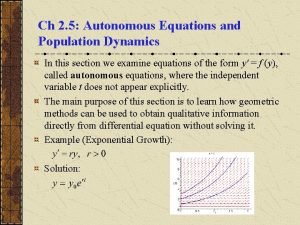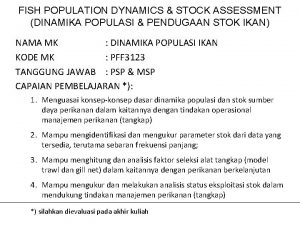INTRODUCTION TO FISH POPULATION DYNAMICS AND STOCK ASSESSMENT








- Slides: 8

INTRODUCTION TO FISH POPULATION DYNAMICS AND STOCK ASSESSMENT

Population dynamics is a branch of life science which is concerned with the short- and long-term changes in the size and age composition of populations, and the biological and environmental processes influencing those chances. Population dynamics deals with the way populations are affected by birth and death rates, and by immigration and emigration, and studies topics such as ageing populations or population decline The best mathematical model that governs the population dynamics of any given species is called the

Population dynamics conted ……. Population dynamics has traditionally been the dominant branch of mathematical biology, which has a history of more than 210 years, although more recently the scope of mathematical biology has greatly expanded The first principle of population dynamics is widely regarded as the exponential law of Malthus, as modelled by the Malthusian growth model. A more general model formulation was proposed by F. J. Richards in 1959, further expanded by Simon Hopkins, in which the models of Gompertz, Verhulst and also Ludwig von Bertalanffy are covered as special cases of the general formulation

Population dynamics conted ……. The Lotka-Volterra predator-prey equations are another famous example. In fisheries and wildlife management, population is affected by three dynamic rate functions, such as Natulity or birth rate, population growth rate and mortality Population is usually defined as aggregates of individuals of the same species, inhabiting a well defined geographical area Such population gets cut off from another discrete population of the same species by a discontinuity between their distributional ranges. Mechanics is a science of statics and dynamics of bodies Dynamics is concerned with the geographical aspects of motions of bodies

Population dynamics conted ……. Kinematics is concerned that causes the motion of bodies Kinetics is concerned with the effect of forces as they condition these motions Statics deals with bodies which are at rest and with forces in equilibrium

Stock assessment is an important tool in fisheries management In particular, to ensure contained, healthy, fish stocks, measurements of the Spawning Stock Biomass (the stock population capable of reproducing) allows sensible conservation strategies to be developed and maintained through the application of sustainable fishing quotas In fisheries management, stock refers to a harvested or managed unit of a fish. Typically stocks are divided based on geographical location and not based on individual population Stocks are not always composed of a single species. Stocks can be composed of multiple species due to their being harvested together or as a form of convenience for managers

Stock assessment conted ……. Stocks are not always composed of a single species. Stocks can be composed of multiple species due to their being harvested together or as a form of convenience for managers An example of a multispecies stock is river herring. Alewives and blueback herring are labeled as river herring for management purposes due to their similar physical appearances and being harvested together Individuals within a stock are subdivided into cohorts. A cohort is a group of fish born in the same year within a population or stock.

END
 Fish population dynamics and stock assessment
Fish population dynamics and stock assessment One fish two fish red fish blue fish ride
One fish two fish red fish blue fish ride Population ecology section 1 population dynamics
Population ecology section 1 population dynamics Population ecology section 1 population dynamics answer key
Population ecology section 1 population dynamics answer key Population ecology section 1 population dynamics
Population ecology section 1 population dynamics Chapter 4 section 1 population dynamics study guide answers
Chapter 4 section 1 population dynamics study guide answers One fish two fish blowfish blue fish
One fish two fish blowfish blue fish Scale types fish
Scale types fish Autonomous equations and population dynamics
Autonomous equations and population dynamics














